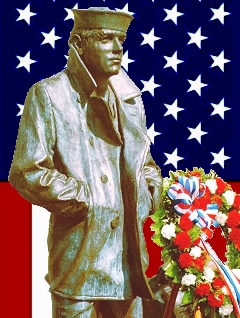

MACHINIST
MATE SECOND CLASS HENRY PHILIP FAVREAU was born
around 1884. He had enlisted in the United States Navy at the
age of 16. A career sailor, he had married, and made his home
with his wife Bertha at 1307 Lansdowne Avenue in Camden NJ. At
the outbreak of World War I, he was serving aboard the USS
Jacob Jones DD-61. It should be noted that his name has
been recorded as Favereau, in the book Camden County In The
Great War.
Jacob
Jones, a Tucker-class destroyer, was launched 29 May 1915
at the New
York Shipbuilding Corporation shipyards in Camden NJ. She
was was commissioned in February 1916. Also aboard the Jacob
Jones was another career sailor, Fireman First Class William
F. Laskowski Jr., who lived a few blocks away at 1151
Haddon Avenue.
The
Jacob Jones served along the East Coast during the next
year and conducted war patrols in the same area for a month
after the United States' April 1917 entry into the First World
War. In May 1917, Jacob Jones, under the command of
Lieutenant Commander David Bagley crossed the Atlantic to
begin anti-submarine patrols and convoy escort work out of
Queenstown, Ireland. She rescued survivors of several
torpedoed ships during the next several months. Arriving
Queenstown, May 17, she immediately began patrol and convoy
escort duty in waters of the United Kingdom. On July 8 she
picked up 44 survivors of the British steamship Valetta, the
victim of a German U-boat. Two weeks later, while escorting
British steamship Dafila, Jacob Jones sighted a periscope; but
the steamship was torpedoed before an attack on the submarine
could be launched. Once again a rescue ship, Jacob Jones took
on board 25 survivors of the stricken Dapfila. On
19 October she picked up 305 survivors of torpedoed British
cruiser Orama.
On
December 6, 1917 Jacob Jones was one of six destroyers
returning from Brest after escorting a convoy to France. At
1621, as she steamed independently in the vicinity of the
Isles of Scilly, her watch sighted a torpedo wake about a
thousand yards distant. Although the destroyer maneuvered to
escape, the high-speed torpedo struck her starboard side,
rupturing her fuel oil tank. The torpedo
was from the German submarine U-53.
The crew worked courageously to save the ship;
but as the stern sank, her depth charges exploded. Realizing
the situation hopeless, Comdr. Bagley reluctantly ordered the
ship abandoned. Eight minutes after being torpedoed, Jacob
Jones sank with 64 men still on board.
Of
the 38 survivors, two were taken prisoner by the U-boat,
others rescued by two British ships that responded to a radio
signal sent out by U-53ís
Captain, Hans Rose, and reportedly, Lieutenant Commander
Bagley and five others managed to row ashore. The U-53
sank over 90 ships in 1917 and 1918, and survived the war.
Henry
Favreau was 33 when he was killed in action. He was survived
by his wife Anna, of 1241 Lemon Street in Camden NJ. The book
"Camden County in the Great War" gives Mrs.
Favreau's first name as Bertha, and an address of 1307
Lansdowne Avenue, in Camden NJ.